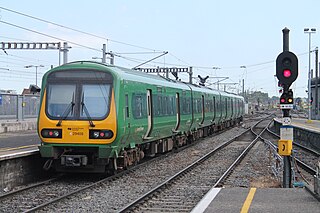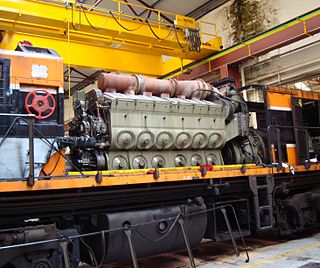
A diesel multiple unit or DMU is a multiple-unit train powered by on-board diesel engines. A DMU requires no separate locomotive, as the engines are incorporated into one or more of the carriages. Diesel-powered single-unit railcars are also generally classed as DMUs. Diesel-powered units may be further classified by their transmission type: diesel–electric (DEMU), diesel–mechanical (DMMU) or diesel–hydraulic (DHMU).

A locomotive or engine is a rail transport vehicle that provides the motive power for a train. If a locomotive is capable of carrying a payload, it is usually rather referred to as multiple units, motor coaches, railcars or power cars; the use of these self-propelled vehicles is increasingly common for passenger trains, but rare for freight.

A diesel locomotive is a type of railway locomotive in which the prime mover is a diesel engine. Several types of diesel locomotive have been developed, differing mainly in the means by which mechanical power is conveyed to the driving wheels.
As used in mechanical engineering, the term tractive force can either refer to the total traction a vehicle exerts on a surface, or the amount of the total traction that is parallel to the direction of motion.

Dynamic braking is the use of an electric traction motor as a generator when slowing a vehicle such as an electric or diesel-electric locomotive. It is termed "rheostatic" if the generated electrical power is dissipated as heat in brake grid resistors, and "regenerative" if the power is returned to the supply line. Dynamic braking reduces wear on friction-based braking components, and regeneration lowers net energy consumption. Dynamic braking may also be used on railcars with multiple units, light rail vehicles, electric trams, trolleybuses and electric and hybrid electric automobiles.

A DC motor is any of a class of rotary electrical machines that converts direct current electrical energy into mechanical energy. The most common types rely on the forces produced by magnetic fields. Nearly all types of DC motors have some internal mechanism, either electromechanical or electronic, to periodically change the direction of current in part of the motor.
A traction motor is an electric motor used for propulsion of a vehicle, such as locomotives or electric roadway vehicle.

The EMC E2 was an American passenger-train diesel locomotive which as a single unit developed 1,800 horsepower (1,300 kW), from two (2) 900 horsepower (670 kW) prime movers. These locomotives were typically operated as a unit set ; where the three unit lashup developed 5400 horsepower. This was almost the ideal horsepower required for the tonnage of a 15 - 18 car passenger train, operated over the ruling grades of virtually all of the mileage between major American cities. The units were of the A1A-A1A wheel arrangement, and manufactured by Electro-Motive Corporation (EMC), later Electro-Motive Diesel (EMD) of La Grange, Illinois.
The following lists events that happened during 1923 in South Africa.
Electro-Motive Diesel (EMD) is an American manufacturer of diesel-electric locomotives, locomotive products and diesel engines for the rail industry. The company is owned by Caterpillar through its subsidiary Progress Rail Services.
The Indian Railway Service of Mechanical Engineering (IRSME) is a prestigious group 'A' central service of the Government of India. The officers of this service are responsible for managing the Mechanical Engineering Organisation of the Indian Railways.IRSME officers are drawn from the Engineering Service Examination(ESE) Exam.All appointments to the Group 'A' services are made by the President of India.[7]

The British Rail Class 124 diesel multiple units were built by BR Swindon Works in 1960.

Mechanical railway signalling installations rely on lever frames for their operation to interlock the signals, track locks and points to allow the safe operation of trains in the area the signals control. Usually located in the signal box, the levers are operated either by the signalman or the pointsman.

In engineering, a prime mover is an engine that converts fuel to useful work. In locomotives, the prime mover is thus the source of power for its propulsion. In an engine-generator set, the engine is the prime mover, as distinct from the generator.

An Ausbesserungswerk is a railway facility in German-speaking countries, the primary function of which is the repair of railway vehicles or their components. It is thus equivalent to a 'repair shop' or 'works'. It is also referred to as a Centralwerkstatt or Zentralwerkstatt or Hauptwerkstatt. During the Deutsche Reichsbahn-Gesellschaft (DRG) period between the two world wars these facilities were called Reichsbahnausbesserungswerke (RAW).

The GE C40-8M is a 6-axle diesel locomotive built by GE Transportation Systems from 1990 to 1994. It is part of the GE Dash 8 Series of freight locomotives, and is often referred to as a Dash 8-40CM.

The South African Railways Class 61-000 of 1959 was a diesel-hydraulic locomotive.

The South African Railways gas-electric locomotive of 1923 was an experimental gas-electric locomotive. The fuel, suction gas, was generated on-board the locomotive from coal.
This page is based on this
Wikipedia article Text is available under the
CC BY-SA 4.0 license; additional terms may apply.
Images, videos and audio are available under their respective licenses.












